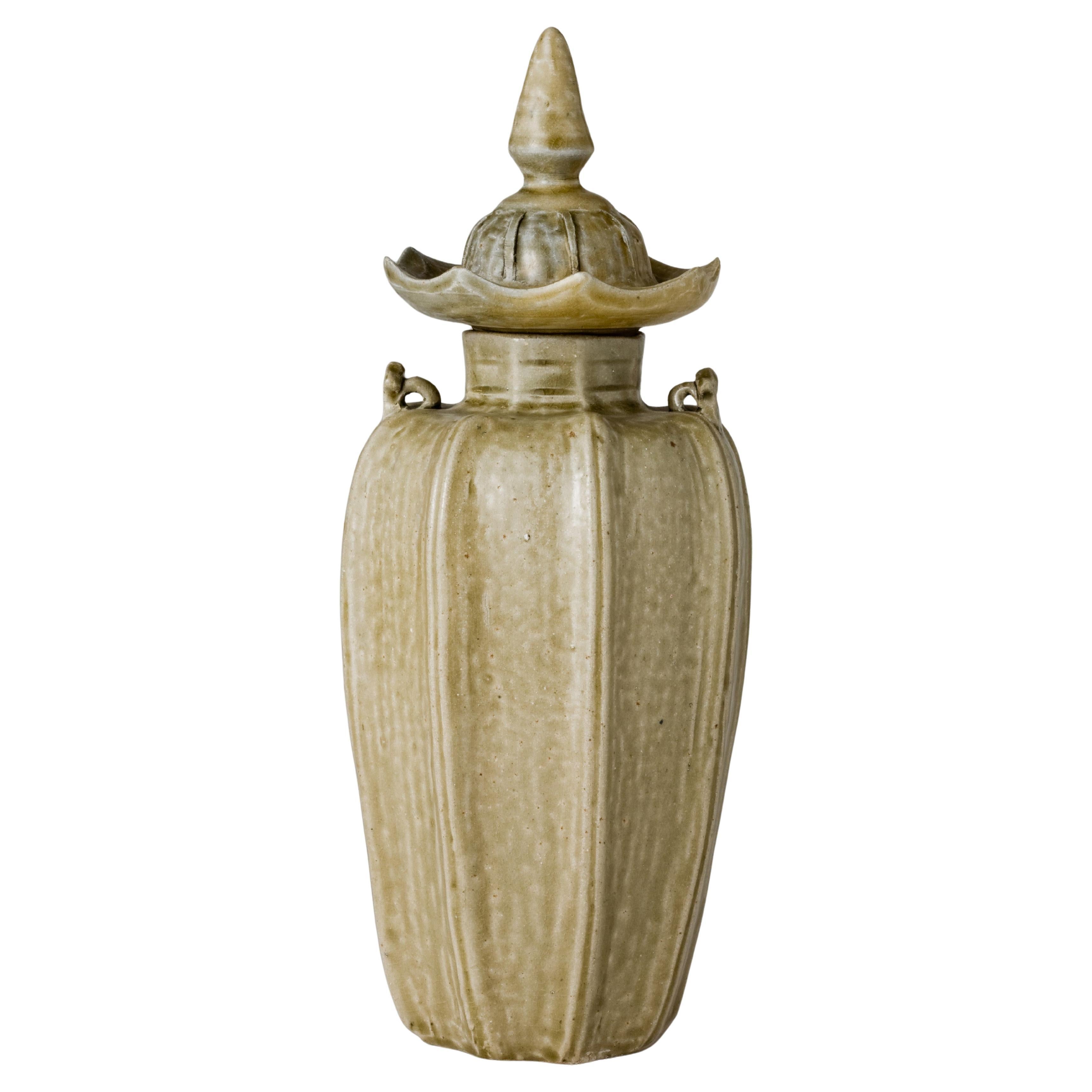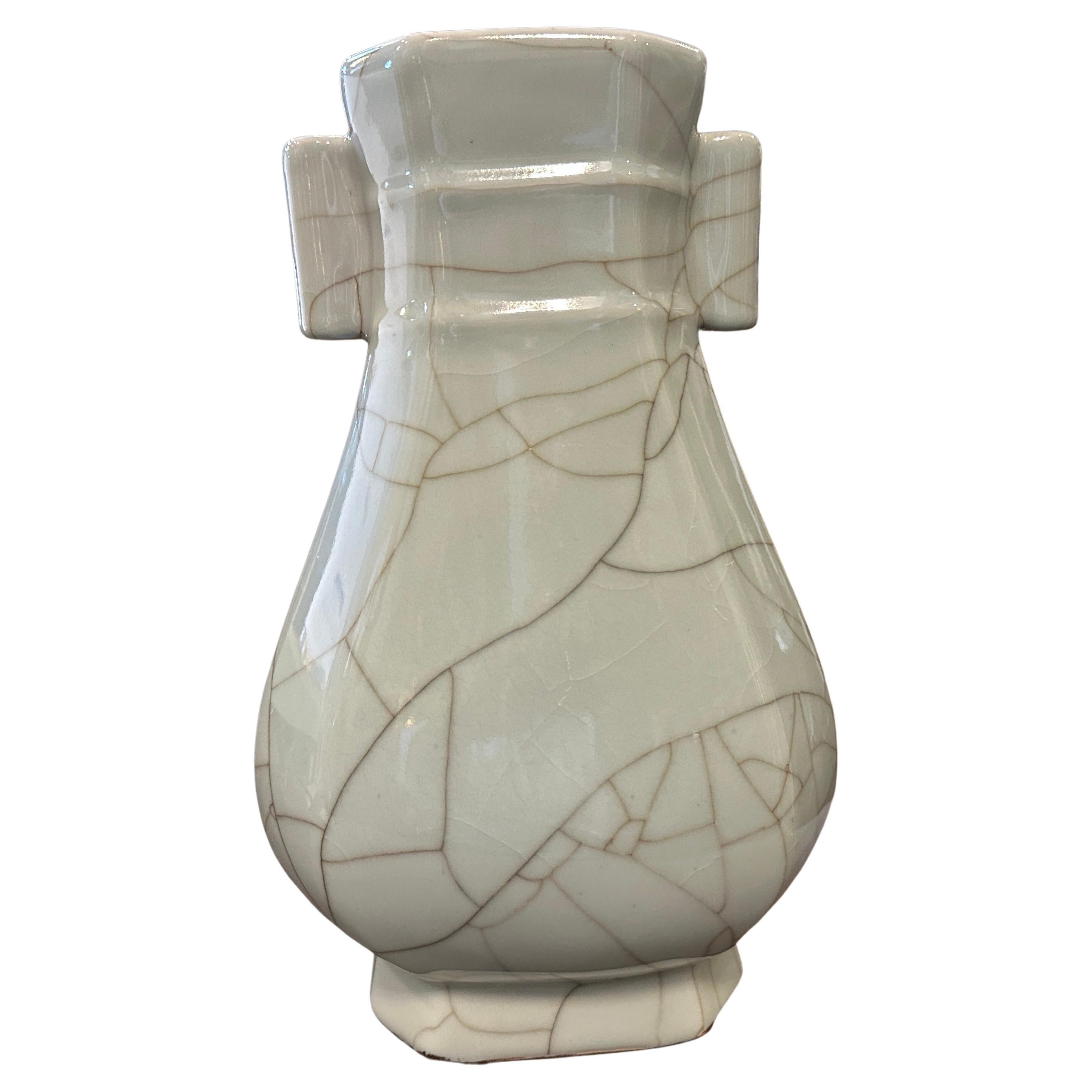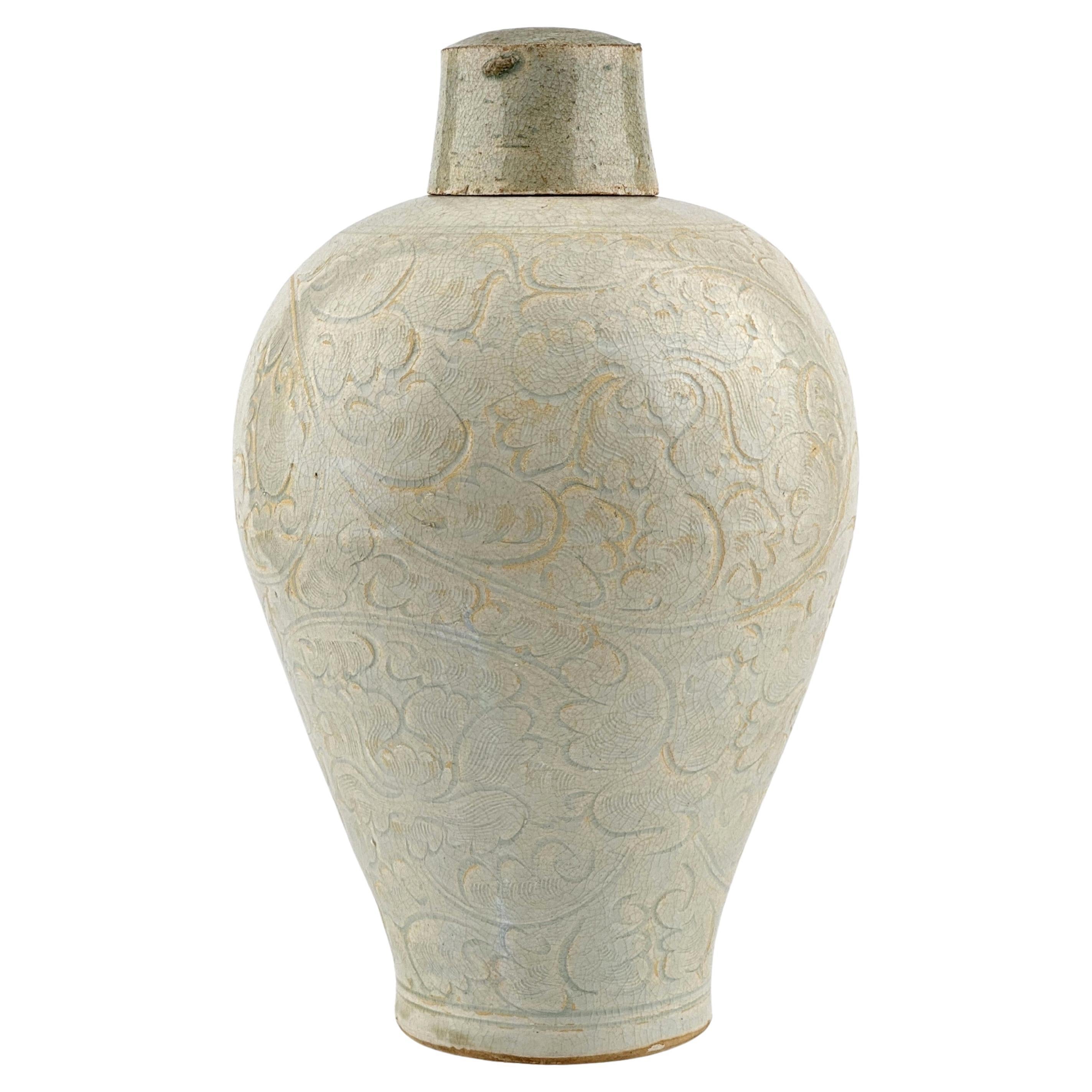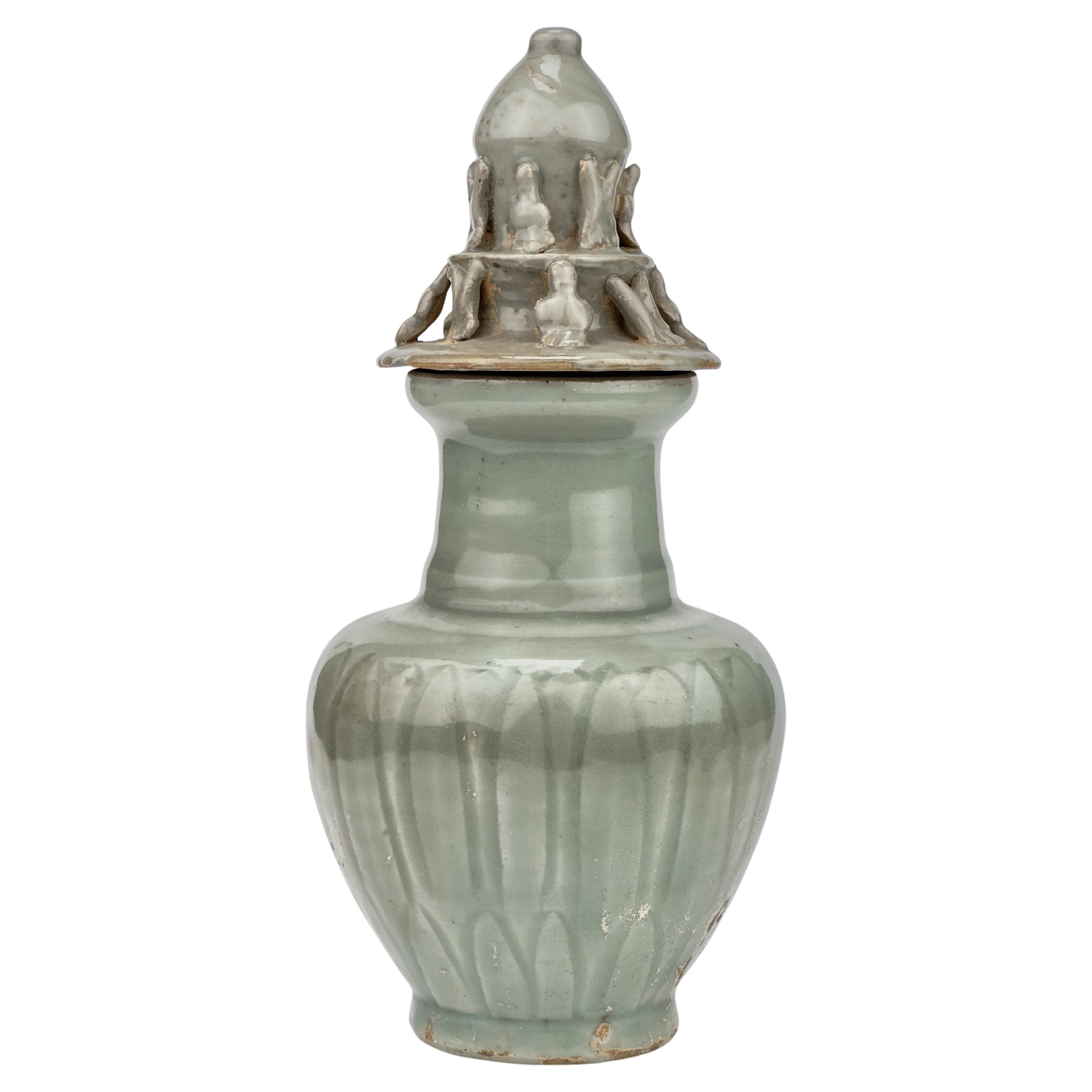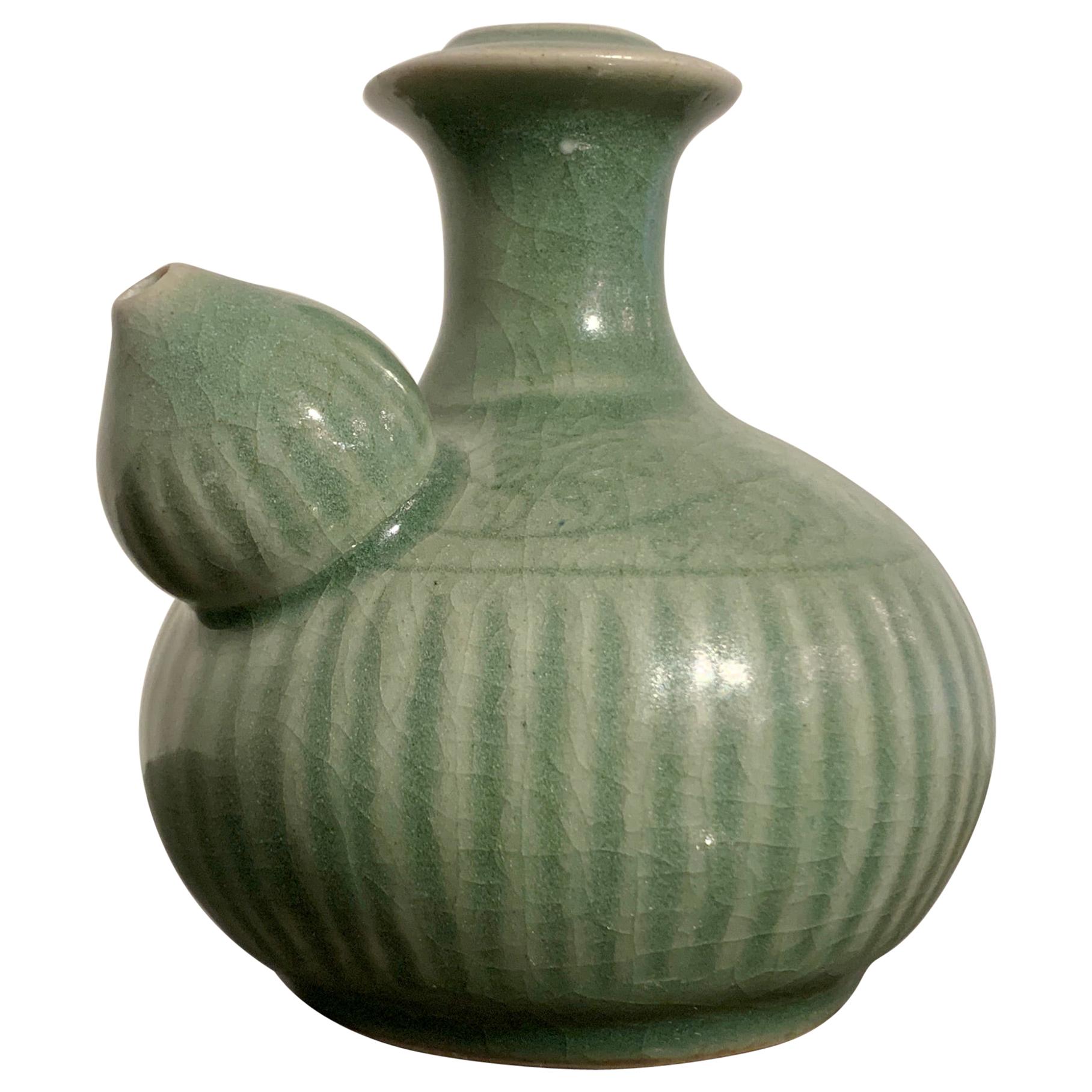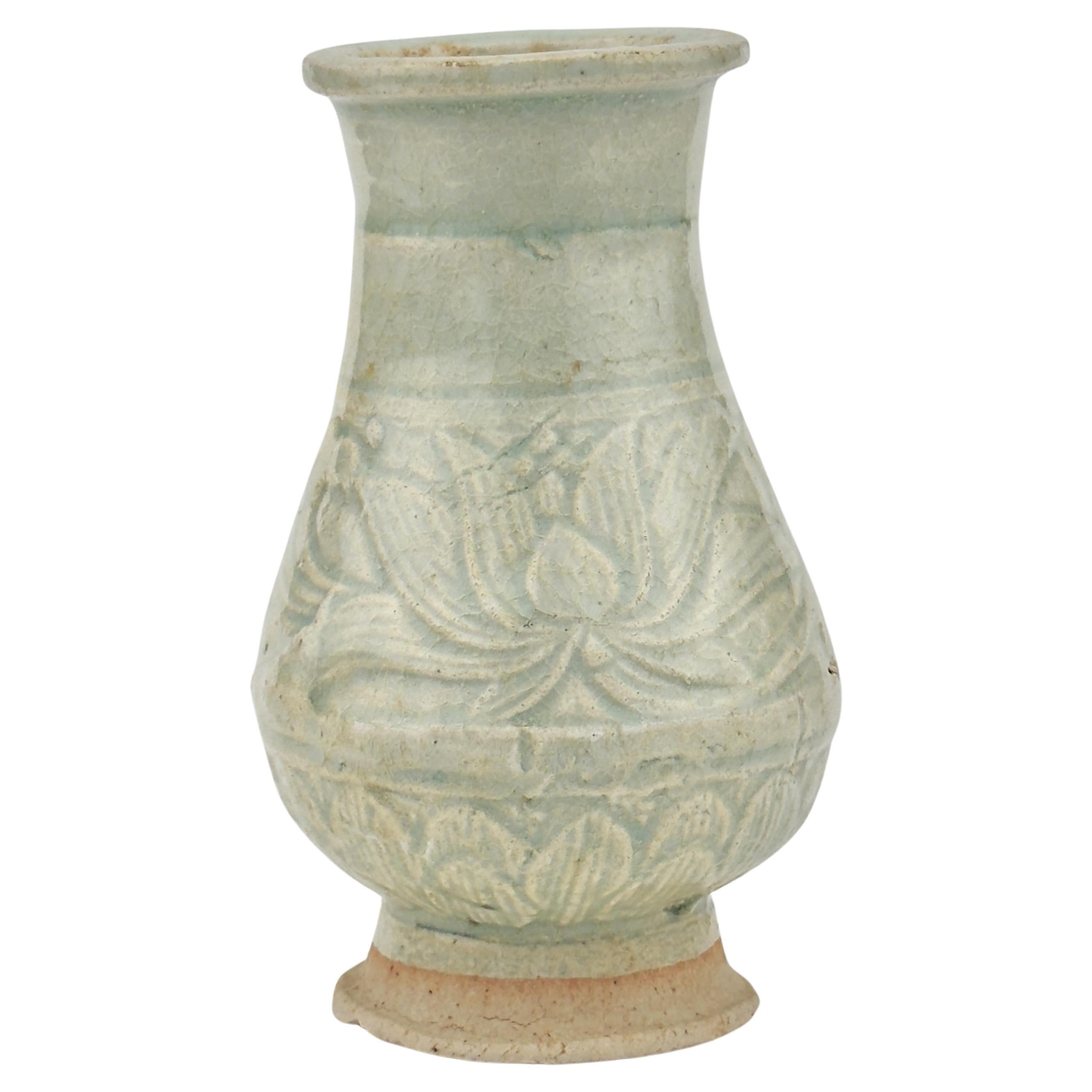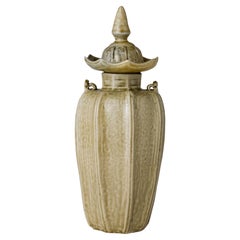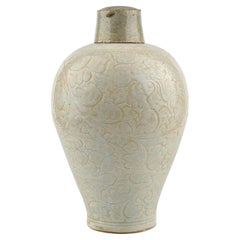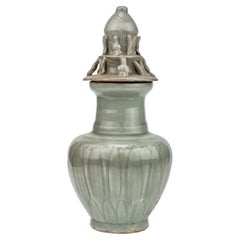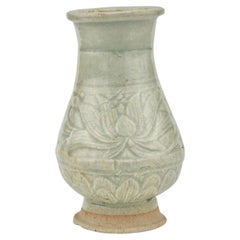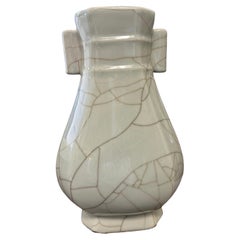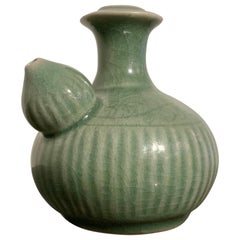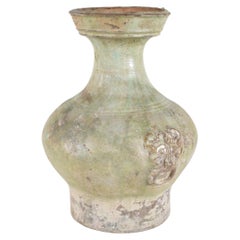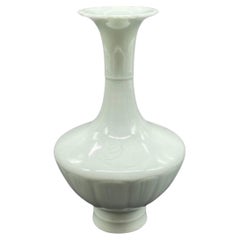Items Similar to Porcelain with transparent pale-bluish (qingbai-type) glaze, Yuan Dynasty
Want more images or videos?
Request additional images or videos from the seller
1 of 8
Porcelain with transparent pale-bluish (qingbai-type) glaze, Yuan Dynasty
$1,225
$1,75030% Off
£925.95
£1,322.7830% Off
€1,064.08
€1,520.1130% Off
CA$1,705.80
CA$2,436.8630% Off
A$1,897.64
A$2,710.9130% Off
CHF 994.77
CHF 1,421.0930% Off
MX$23,188.67
MX$33,126.6830% Off
NOK 12,667.10
NOK 18,095.8630% Off
SEK 11,924.32
SEK 17,034.7530% Off
DKK 7,942.95
DKK 11,347.0730% Off
Shipping
Retrieving quote...The 1stDibs Promise:
Authenticity Guarantee,
Money-Back Guarantee,
24-Hour Cancellation
About the Item
This piece is shaped like a lotus bud, featuring a gracefully undulating body and intricate geometric patterns. The neck is adorned with finely incised dense lines, adding visual variety. The glaze is evenly applied overall, with delicate craquelure and natural tonal variations that reflect the passage of time.
The base remains exposed, revealing traces of glaze flow that occurred during the firing process, along with natural kiln ash and support stone marks.
Period : Yuan Dynasty(1271-1368)
Type : Vase
Medium : Qingbai Ware
Provenance : Acquired in late 1990s, Hongkong
Reference :
1) Smithsonian National Museum of Asian Art - Accession Number F1984.18
2) Ashmolean Museum, Oxford - Accession no.LI1301.295
* Qingbai Ware
Qingbai ware, which translates to "blue-white ware," is a type of Chinese porcelain that was made at the Jingdezhen and other kilns in the porcelain-producing regions of China, primarily during the Song dynasty (960–1279) and continuing into the Yuan dynasty (1271–1368). It is known for its translucent quality and the pale blue-green glaze that characterizes most of its pieces.
The qingbai glaze was achieved using a small amount of iron in a reduction-fired atmosphere, which produced the subtle blue-green tint. The body of qingbai ware is typically made of a fine, white porcelain that is often referred to as 'artificial jade' due to its resemblance to the esteemed stone. The thinness of the body and the high firing temperatures used contributed to the translucent quality of the finished product.
Qingbai ware includes a range of items such as bowls, cups, vases, and ewers. The designs are usually simple and elegant, with an emphasis on the graceful lines and form of the objects. Decorative motifs, when present, are often incised, carved, or molded in relief and can include floral patterns, dragons, phoenixes, and other symbolic elements drawn from Chinese culture.
Over time, the technology and techniques used to produce qingbai ware evolved, leading to innovations in glaze and decoration that would influence later types of Chinese porcelain. Despite these changes, qingbai ware remains a distinguished example of the potters' art in Song and Yuan China, reflecting the refined aesthetic and cultural values of the period.
- Dimensions:Height: 6.7 in (17 cm)Diameter: 3.75 in (9.5 cm)
- Materials and Techniques:
- Place of Origin:
- Period:
- Date of Manufacture:14th century
- Condition:Minor fading.
- Seller Location:seoul, KR
- Reference Number:1stDibs: LU9577243864752
About the Seller
4.8
Gold Seller
Premium sellers maintaining a 4.3+ rating and 24-hour response times
Established in 1999
1stDibs seller since 2023
38 sales on 1stDibs
Typical response time: <1 hour
- ShippingRetrieving quote...Shipping from: seoul, Korea South
- Return Policy
Authenticity Guarantee
In the unlikely event there’s an issue with an item’s authenticity, contact us within 1 year for a full refund. DetailsMoney-Back Guarantee
If your item is not as described, is damaged in transit, or does not arrive, contact us within 7 days for a full refund. Details24-Hour Cancellation
You have a 24-hour grace period in which to reconsider your purchase, with no questions asked.Vetted Professional Sellers
Our world-class sellers must adhere to strict standards for service and quality, maintaining the integrity of our listings.Price-Match Guarantee
If you find that a seller listed the same item for a lower price elsewhere, we’ll match it.Trusted Global Delivery
Our best-in-class carrier network provides specialized shipping options worldwide, including custom delivery.More From This Seller
View AllA Rare 'Yue' Celadon Glazed Octagonal Vase, Western Jin Dynasty (266 - 316 AD)
Located in seoul, KR
Finely potted with incurved facetted sides divided by raised ribs and set with two short lugs to the shoulder, the body rising to a short octagonal neck, the domed cover of conforming section, surrounded by an upturned rim and surmounted by a bud finial, applied overall with a celadon glaze of the period.
A related vase of this rare and charming form, in the Zhenjiang Museum, Zhenjiang, is illustrated in the Complete Collection of Chinese Ceramics. Song, vol. 8, Shanghai, 1999, pl. 52. Vases of related octagonal shape were produced at the Ding kilns, in Hebei province, and the qingbai kilns in Jiangxi province; see a Ding vase in the Palace Museum, Beijing, illustrated in Selection of Ding Ware. The Palace Museum’s Collection and Archaeological Excavation, Beijing, 2002, pl. 37; and a qingbai example, from the Meiyintang collection, illustrated in Regina Krahl, Chinese Ceramics from the Meiyintang Collection, vol. 3 (II), London, 2006, pl. 1590; and another carved with a floral scroll, included in the exhibition Song Ceramics from the Kwan Collection, Hong Kong Museum of Art, Hong Kong, 1994, cat. no. 105.
Period : Western Jin Dynasty (266 - 316 AD)
Type : Octagonal Vase
Medium : Yue celadon...
Category
Antique 15th Century and Earlier Hong Kong Han Antiquities
Materials
Celadon
$19,975 Sale Price
75% Off
A Qingbai Carved Meiping Porcelain, Song Dynasty
Located in seoul, KR
The vase exhibits a finely crafted structure, characterized by its wide shoulders and elongated, tapering sides, topped with a compact, ribbed cylindrical neck. Its exterior is adorn...
Category
Antique 15th Century and Earlier Hong Kong Ceramics
Materials
Ceramic, Porcelain
$6,965 Sale Price
65% Off
Carved 'Longquan' Celadon-glazed Funerary vase and cover, Song dynasty
Located in seoul, KR
The vase features a ribbed body, subtly enhancing its graceful contours, and is topped with a uniquely sculpted lid adorned with figurative elements.
Period : Song Dynasty
Type : Ce...
Category
Antique 15th Century and Earlier Hong Kong Antiquities
Materials
Celadon
$3,995 Sale Price
50% Off
White Ware Moulded Baluster Form, Yuan Dynasty, 14th century
Located in seoul, KR
This vase is made from a type of low-fired, porous clay and features a crackled glaze. It bears resemblance to the renowned funerary vases and covers adorned with applied decorations...
Category
Antique 15th Century and Earlier Hong Kong Antiquities
Materials
Ceramic, Porcelain
$950 Sale Price
50% Off
Qingbai Yuhuchunping Vase Porcelain, Song Dynasty
Located in seoul, KR
Covered with a fine bluish glaze, the body entirely decorated with an incised decoration of elegant leafy scrolls and blooming lotuses. "Yuhuchunping" translates to 'spring wine bott...
Category
Antique 15th Century and Earlier Hong Kong Ceramics
Materials
Ceramic, Porcelain
$7,950 Sale Price
50% Off
Celadon Vase, Five Dynasties or Northern Song dynasty, 10th-11th Century
Located in seoul, KR
The form of Longquan celadon vases from the Northern Song dynasty evolved from an early design with a long neck and tapering body to a later ovoid body with a shorter neck. Over time, the glaze developed a more olive tone, and the carved decorations became more pronounced and intricate. Examples of such vases include one without a cover dated to the Yuanfeng era (1078~1085) and documented in literature, and another similar vase without loop handles preserved by the Qingyuan County Cultural Relics Bureau. An earlier example featuring loop handles and a lotus-like cover is also mentioned in historical texts.
The use of Longquan covered vases, especially as funerary jars for offerings like wine and grains, was highlighted by an inscription on a piece from the Sir Percival David Collection, London. This inscription wishes for the vessel to preserve fragrant wine for centuries, blessing the owner with prosperity, longevity, and a vast lineage, dated to the third year of the Yuanfeng period (1080). This practice was common in the regions of Southern Zhejiang and Northern Fujian. A similar celadon vase from the Linyushanren collection was auctioned at Christie’s Hong Kong, emphasizing the cultural and historical significance of these artifacts.
Period : Five Dynasties or Northern Song Dynasty
Type : Celadon, Zhejiang province
Medium : Celadon
Size : 31.5 cm(Height) x 11.5(Diameter)
Provenance : Acquired in late 1990s from Hongkong
Reference :
1) The British Museum image id - 01613270570
2) Christies New York 23–24 MAR 2023 - Important Chinese Ceramics and Works of Art - Lot 1012
(Price Range : USD 18,000 – USD 25,000 / Type : Related)
3) National Gallery of Victoria - Accession Number - AS5-1973
* Celadon from Five Dynasties (907~960) to the early Northern Song Dynasty (960~1127)
The period from the Five Dynasties (907~960) to the early Northern Song Dynasty (960~1127) marked a significant transitional phase in the development of Chinese celadon ceramics...
Category
Antique 15th Century and Earlier Hong Kong Antiquities
Materials
Celadon
$3,960 Sale Price
60% Off
You May Also Like
20th Century Greyish Celadon Glazed Chinese Porcelain Vase
Located in Catania, Sicilia
A simple and elegant well shaped Celadon vase manufactured in China in the early 20th century, the vase is covered overall with a crackled grey celadon glaze. The glaze it's smooth a...
Category
Antique Late 19th Century Chinese Chinese Export Ceramics
Materials
Celadon
Small Chinese Celadon Glazed Porcelain Kendi, Qing Dynasty, 18th Century, China
Located in Austin, TX
A darling small Chinese celadon glazed kendi, or pouring vessel, mid Qing Dynasty, 18th century, China, for the Southeast Asian market.
The diminutive kendi of typical form, with ...
Category
Antique 18th Century Chinese Qing Ceramics
Materials
Porcelain
A Han (206BC -220AD) Glazed Hu Vessel
Located in Chicago, IL
This is a fine, heavily patinated example of a Han hu wine storage vessel, buried for the afterlife. The compressed globular body narrows to a slender waisted neck, covered with a da...
Category
Antique 15th Century and Earlier Chinese Han Antiquities
Materials
Terracotta
A Pale Celadon Glazed Bottle Vase, Xuanhe Mark, 20th Century or Possibly Earlier
Located in ARMADALE, VIC
A Pale Celadon Glazed Bottle Vase, Xuanhe Mark, 20th Century or Possibly Earlier
Description:
The fine lobed body with flared scalloped floriate rim and raised foot. Incised with ru...
Category
20th Century Chinese Ceramics
Materials
Porcelain
$270 Sale Price
40% Off
Free Shipping
Antique Chinese Celadon Blue And White Vase
Located in Norwood, NJ
A large antique 19th century Chinese floor vase having a celadon ground and blue and white underglaze decoration to the body. The underglaze decoration is of a Fenghuang (Phoenix) bi...
Category
Antique Late 19th Century Chinese Chinese Export Vases
Materials
Porcelain
Jun Ware Chinese Porcelain Vase, Tang Dynasty Style, Vase 3
Located in Somis, CA
A splendid Jun ware porcelain Yu Tang Chun vase. Jun ware, is one of the most important kilns in China. Originated in Tang dynasty, Jun kiln produces the most...
Category
20th Century Chinese Tang Ceramics
Materials
Porcelain
More Ways To Browse
Song Dynasty Furniture
Antique Iron Glaze
Lotus Porcelain
Antique Flow Blue
Porcelain Phoenix
Song Porcelain
Chinese Porcelain Iron
Song Dynasty Vase
Thin Porcelain Chinese
Song Dynasty Porcelain
Blue And White Porcelain Dragon
14th Century China
Chinese 14th Century
Flow Blue China
Chinese Dragon And Phoenix
Chinese And Porcelain And Phoenix
Chinese Porcelain Phoenix
Chinese Jade Vase
